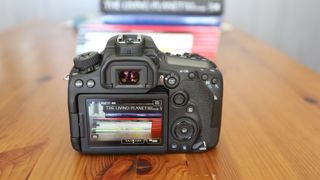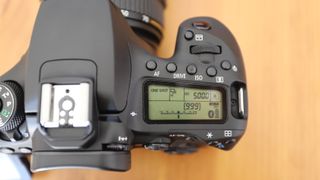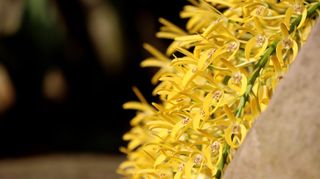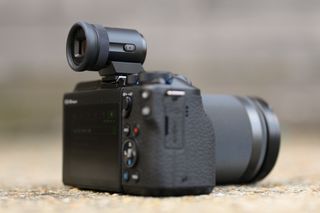Canon EOS 90D review
Canon EOS 90D review
Canon proves there's still life in DSLRs in the age of mirrorless

OUR VERDICT
There’s a lot to recommend the Canon EOS 90D – it’s a full-featured DSLR with the speedy performance to match. The deeper grip makes it comfortable to use for long periods of time, as does its impressive battery life. And it’s been priced to appeal to most enthusiasts. For anyone unwilling to make the move to the mirrorless fray, this snapper is a formidable all-round option.
FOR
- High-resolution image sensor
- Uncropped 4K/30p video
- Ergonomic grip
- Joystick control
AGAINST
- No image stabilization
- Default JPEG noise reduction level insufficient
The EOS 80D was one of Canon’s most popular enthusiast-level DSLRs – it had an excellent sensor that captured plenty of detail while keeping noise levels to the minimum. So it’s natural to expect its successor to outdo the EOS 80D in every way possible and the EOS 90D – which launched alongside the EOS M6 Mark II in August 2019 – does a remarkable job of filling some big shoes.
The 90D packs way more pixels than its predecessor and gets a much-needed speed boost as well, thanks to the latest imaging engine from Canon. Like the 80D, the new camera is user friendly, with a price tag that’s pocket-friendly too – it’s on shelves for $1,199 / £1,210 / AU$1,959 (matching the launch price of the 80D in the US) – positioning it well as a general-purpose shooter for both beginners as well as enthusiasts keen on capturing a wide variety of situations.
- Canon EOS 90D at Amazon for US$1,199
To put it simply: with the 90D, Canon has proven that DSLRs aren’t quite ready to kick the bucket yet.
Features
- New 32.5MP APS-C sensor
- 220K RGB+IR metering sensor
- Uncropped 4K video
At first glance, there’s not much physical difference between the EOS 80D and its new successor. The innards, however, are brand-spanking new, with a 32.5MP APS-C CMOS sensor taking centerstage. Historically, sensor resolution of most APS-C cameras has topped out at about 24MP – meaning the 90D (and the EOS M6 Mark II with the same sensor) offers the highest resolution found in the crop-sensor class of cameras.
The advantage of having this kind of resolution means you’ll be able to capture more details while giving you the flexibility to crop an image during post-processing, allowing you to zoom in closer to your subject without compromising image quality. While the higher resolution is a welcome boost, it can result in more noise in images shot at higher ISOs compared to cameras in the same sensor class but lower resolutions. This happens because individual pixels have to be shrunk to fit a higher number of them in a limited space.
CANON EOS 90D: KEY SPECS
Sensor: 32.5MP APS-C CMOS sensor
Image processor: Digic 8
AF points: 45 cross-type points
ISO range: 100 to 25,600 (expandable to 51,200)
Video: 4K up to 30fps/1080p up to 120fps
Max burst: Up to 11fps (with Live View)
Connectivity: Wi-Fi, Bluetooth, USB 2.0
Battery: CIPA rating of 1,300 shots
Weight: 701g (with battery and card)
Image processor: Digic 8
AF points: 45 cross-type points
ISO range: 100 to 25,600 (expandable to 51,200)
Video: 4K up to 30fps/1080p up to 120fps
Max burst: Up to 11fps (with Live View)
Connectivity: Wi-Fi, Bluetooth, USB 2.0
Battery: CIPA rating of 1,300 shots
Weight: 701g (with battery and card)
However, it’s Canon’s latest Digic 8 image processor that gives the 90D a major performance boost over the 80D and its Digic 6 engine. The latest processor gives the new snapper the ability to shoot 4K video, where the 80D topped out at just 1080p (aka Full HD) resolution. And, unlike all other Canon cameras, the new EOS R and EOS RP included, video capture utilizes the entire width of the 90D’s sensor – a first for the company. Videos themselves are captured in the MP4 file format in either 4K UHD (3840 x 2160) quality to a maximum 30fps, in Full HD (1920 x 1080) at up to 60fps or Standard HD (1280 x 720) at 60fps, and with a maximum duration of 30 minutes.
The Digic 8 processor also ups the ante when it comes to maximum burst speed and native ISO range. The former sees a jump from the 80D’s 7fps to a faster 10fps with continuous autofocus (or 11fps when using Live View), while the 90D has a native ISO range of 100 to 25,600, expandable to 51,200 (unlike the 80D’s native high ISO of 16,000 and maximum expansion value of 25,600 ).

(Image credit: Future)
When it comes to focus points, the new camera shares the 80D’s 45-point cross-type AF system. However, a new 220,000-pixel RGB+IR metering sensor (the 80D has a 7,560-pixel one) adds face detection when using the camera’s viewfinder, and can be called upon for both stills and video. Face Detect is available automatically when using the 90D’s Intelligent Tracking and Recognition Autofocus (iTR AF) feature.
Canon’s superb Dual Pixel CMOS AF is available when using Live View and covers about 100% of the frame vertically and 88% horizontally, with a staggering 5,481 AF points to choose from manually. And what makes this system a pleasure to use is the joystick found on the right of the display, giving greater precision when choosing a focal point. With a working range of -3EV to 18, the camera won’t quite match the low-light performance of Canon’s full-frame mirrorless cameras but will work well for most users in poor lighting conditions.
Advertisement

(Image credit: Future)
Taking a leaf out of the EOS RP’s book, the 90D shares it's full-frame mirrorless cousin’s eye detection when using Live View, which can be switched on or off if using Face+Tracking in AF mode.
Also onboard, like most modern cameras, is Wi-Fi and Bluetooth connectivity to connect the camera to a smartphone for quick and easy download of images directly to the device for sharing on social media, or for using the phone as a remote shutter release. For wired data transfer to a computer, the 90D uses a USB Type-C connector but it’s the older 2.0 standard. So if you want files to transfer at lightning speed, you’ll need to look elsewhere, perhaps are newer mirrorless snappers like the EOS R, Nikon Z7 or even Fujifilm's X-T3.
The 90D uses the LP-E6N battery found in some of Canon’s other DSLRs and it comes with a CIPA certification of 1,300 shots when using the viewfinder. That’s an estimated 450 shots when using Live View (or the rear display). For those looking for the security of plenty more battery life, Canon offers the BG-E14 grip to be used with the 90D.
Build and handling
- Aluminum alloy and polycarbonate resin body
- 8-way AF joystick
- Ergonomic grip
Measuring just 140.7(W) x 104.8(H) x 76.8(D) mm, the EOS 90D is a fraction wider than the 80D (coming in at 139 x 105.2 x 78.5mm) but is shorter and thinner. The new camera is also a tad lighter than its predecessor, weighing in at 701g (with battery and SD card) as compared to the 80D at 730g. Most users, however, are unlikely to feel much of a difference.
While the camera isn’t entirely weatherproof (it is water and dust resistant, though), it's an aluminum alloy, polycarbonate resin, and glass fiber body feels sturdily built and is extremely comfortable to use, even over long durations. This is thanks to a redesigned grip that is deeper and slightly thinner than the one on Canon’s older DSLRs. Even if you’ve got small mitts, the 90D is easy to handle. We shot using the EF 24-70mm f/4L IS USM, the 17-40mm f/4L USM, and the EF 70-200mm f/2.8L IS III USM – even with that last monster of a lens, the camera felt well balanced and comfortable.
- Canon EOS 90D at Amazon for US$1,199

(Image credit: Future)
If you’ve ever used a Canon DSLR before, be it the 80D, the 7D Mark II or even the EOS 6D Mark II, you should feel a sense of comfortable familiarity with this new model. A new 8-way joystick on the rear of the camera is a welcome addition, allowing you to choose AF points easily. The default option on the camera to activate AF point selection is by pressing the dedicated button on the shoulder of the 90D. However, an option in the customization menu will move this function to the joystick.
The addition of the joystick means some of the buttons have been moved around a little. It takes the spot the Q button occupied on the 80D (used to quickly access important camera settings), while on the 90D the Q button has moved to where the playback button used to be on the 80D (just above the control dial). The playback button on the 90D has moved to the position that was occupied by the bin button which, in turn, has moved closer to the lock lever. Despite this slight shuffling of controls, using the 90D is still quite instinctive for those familiar with Canon’s other DSLRs.
Build and handling
- Aluminum alloy and polycarbonate resin body
- 8-way AF joystick
- Ergonomic grip
Measuring just 140.7(W) x 104.8(H) x 76.8(D) mm, the EOS 90D is a fraction wider than the 80D (coming in at 139 x 105.2 x 78.5mm) but is shorter and thinner. The new camera is also a tad lighter than its predecessor, weighing in at 701g (with battery and SD card) as compared to the 80D at 730g. Most users, however, are unlikely to feel much of a difference.
While the camera isn’t entirely weatherproof (it is water and dust resistant, though), it's an aluminum alloy, polycarbonate resin, and glass fiber body feels sturdily built and is extremely comfortable to use, even over long durations. This is thanks to a redesigned grip that is deeper and slightly thinner than the one on Canon’s older DSLRs. Even if you’ve got small mitts, the 90D is easy to handle. We shot using the EF 24-70mm f/4L IS USM, the 17-40mm f/4L USM, and the EF 70-200mm f/2.8L IS III USM – even with that last monster of a lens, the camera felt well balanced and comfortable.
- Canon EOS 90D at Amazon for US$1,199

(Image credit: Future)
If you’ve ever used a Canon DSLR before, be it the 80D, the 7D Mark II or even the EOS 6D Mark II, you should feel a sense of comfortable familiarity with this new model. A new 8-way joystick on the rear of the camera is a welcome addition, allowing you to choose AF points easily. The default option on the camera to activate AF point selection is by pressing the dedicated button on the shoulder of the 90D. However, an option in the customization menu will move this function to the joystick.
The addition of the joystick means some of the buttons have been moved around a little. It takes the spot the Q button occupied on the 80D (used to quickly access important camera settings), while on the 90D the Q button has moved to where the playback button used to be on the 80D (just above the control dial). The playback button on the 90D has moved to the position that was occupied by the bin button which, in turn, has moved closer to the lock lever. Despite this slight shuffling of controls, using the 90D is still quite instinctive for those familiar with Canon’s other DSLRs.
Performance
- 58 JPEG or 25 RAW buffer capacity
- Impressive battery
The most impressive bit of the 90D would be its new 216-zone metering system that gathers data from an RGB and infrared sensor that has a staggering 220,000 pixels. Each of the 216 sections is assessed for exposure, doing a great job of adjusting the brightness of the whole frame. By default, the metering mode is set to Evaluative, but you can choose between Partial, Centre-weighted and Spot metering options as well. The evaluative system is excellent for most situations, but the others are well suited to backlit subjects.

- Canon EOS 90D at Amazon for US$1,199
The new metering sensor does a remarkable job in both sunlight and shadows | EOS 90 with EF 70-200mm f/2.8L IS II USM, 1/160 sec at f/32.8, ISO 160
(Image credit: Future)
While the combination of the 90D’s high-resolution sensor and the latest image processor gives the new camera a remarkable turn of speed over its predecessor, it can’t quite match the buffer capacity of the EOS 7D Mark II. This five-year-old shooter is capable of sending 31 RAW files or 1,030 JPEGs to a card. The 90D, on the other hand, has a buffer capacity of just 58 JPEGs and 25 RAW files.
That said, the 11fps burst speed gives Canon the opportunity to market the 90D as a great all-round option. While it can’t match the M6 Mark II’s 14fps, the 90D does very well for both sports and wildlife photography.

EOS 90 with EF 70-200mm f/2.8L IS II USM, 1/1,000 sec at f/5.6, ISO 5000
(Image credit: Future)
When shooting at base ISO, the 90D’s noise performance is excellent. You’ll begin to see grain creeping in at about ISO 6400 but it’s kept at a minimum. Even at ISO 8000, there’s nothing to complain about – the little noise you can see in the shadows and the edges can easily be removed in post-production. Go higher, however, and noise becomes a lot more evident.
Battery life, though, is something to write home about. While the CIPA rating is for 1,300 images, you’ll get way more than that. During our testing, shooting both RAW and JPEG when switching between viewfinder and Live View, we squeezed out about 1,500 shots. If you stick to just using the viewfinder, you’ll be able to push that number to about 1,900.
Image quality
- Detailed 4K footage
- Generally excellent results for stills
We were expecting the 90D to produce some excellent results, thanks to its new sensor, and the camera certainly delivered. There were plenty of details in the results, in both highlights and shadows. However, the increase in sensor resolution means you’ll need to be marginally more careful with how you handle the camera – tiny movements could become apparent in images, so you may need to use faster shutter speeds to achieve the best sharpness. Thankfully, an electronic shutter takes the speed 1/16,000th of a second, allowing for wide apertures when shooting moving subjects.
Unlike the 80D and the 7D Mark II, where the noise was kept to a minimum across the entire native ISO range, that’s not the case with the 90D. While noise is well controlled at lower ISO values, it does become very evident at sensitivities above 8000. From here on in, luminance noise is visible at most viewing sizes.
Image 1 of 6

EOS 90 with EF 70-200mm f/2.8L IS II USM, 1/160 sec at f/2.8, ISO 100
(Image credit: Future)

EOS 90 with EF 70-200mm f/2.8L IS II USM, 1/800 sec at f/5, ISO 5000
(Image credit: Future)
Click here to see the full-size image

EOS 90 with EF 70-200mm f/2.8L IS II USM, 1/250 sec at f/3.5, ISO 100
(Image credit: Future)
Click here to see the full-size image

EOS 90 with EF 70-200mm f/2.8L IS II USM, 1/320 sec at f/2.8, ISO 200
(Image credit: Future)
Click here to see the full-size image

EOS 90 with EF 70-200mm f/2.8L IS II USM, 1/400 sec at f/3.5, ISO 100
(Image credit: Future)
Click here to see the full-size image

EOS 90 with EF 70-200mm f/2.8L IS II USM, 1/320 sec at f/2.8, ISO 800
(Image credit: Future)
Click here to see the full-size image
During our testing, we captured a lot of our images using Canon’s Standard picture style and that was sufficient to prove the 90D carries forward the camera maker’s superb color reproduction, producing pictures with decent saturation. The Vivid and Landscape options are also quite good, with the former offering stronger colors and the latter doing a remarkable job of not oversaturating the blue of the sky or the green of the landscape like some other cameras tend to do.
If you don’t want to fiddle around too much with camera settings when capturing people, the Portrait picture style is a good option, as it doesn’t make skin tones look unnatural. Focus bracketing is also available on the 90D, allowing users to capture a series of images with incremental changes in focus points, which can later be stacked in post-production to enhance the depth of field.
The default Monochrome option, though, produces very flat images, but that can be changed by adding more contrast or changing exposure.
The 90D does very well when shooting video as well. While colors and details are plentiful in any resolution, 4K footage is beautifully sharp. However, you will have to beware of the camera’s rolling shutter as distortions are evident in
Verdict
Most enthusiast photographers are versatile, shooting pretty much anything that catches their fancy. That means they need a camera that can keep up with that versatility, and the EOS 90D definitely does a remarkable job of delivering on that demand.
Water- and dust-resistance means it’s good for any condition but the harshest of weather, plus it’s comfortable to use over long periods of time. It's metering system is top-notch, producing beautifully exposed images across a wide range of situations, and its burst speed is sufficient for most users. The 90D produces excellent results, whether you’re shooting landscapes or trying to capture the perfect serve during a tennis match, provided you don’t need to shoot at high ISO settings.
- Canon EOS 90D at Amazon for US$1,199
The bump in resolution means anyone printing their pictures will find the results looking a lot better on paper compared to a print from a lower-resolution snapper.
It also comes in at a pretty good price point, which should appeal to beginners and enthusiasts alike. Also worth mentioning is the already extensive stable of lenses available for the new camera, especially for anyone already invested in Canon's ecosystem.
The question, though, is whether it’s worth upgrading if you already use the 80D or the 7D Mark II. That will depend on whether you shoot a lot of videos or not. Uncropped 4K at 30fps and 1080p at 120fps make it worthwhile, although if you prefer cinema-like 24fps, you won't find it here. For still photographers, though, the EOS 80D is still available and, despite its age, does a remarkable job.
Competition
Image 1 of 3

(Image credit: Future)
Canon EOS M6 Mark II
Canon launched the second generation EOS M6 alongside the 90D, with both cameras sharing the same sensor and image processor. The APS-C mirrorless cousin, though, has one advantage over the 90D – its burst speed of 14fps – which might appeal more to the traveling wildlife photographer.






No comments